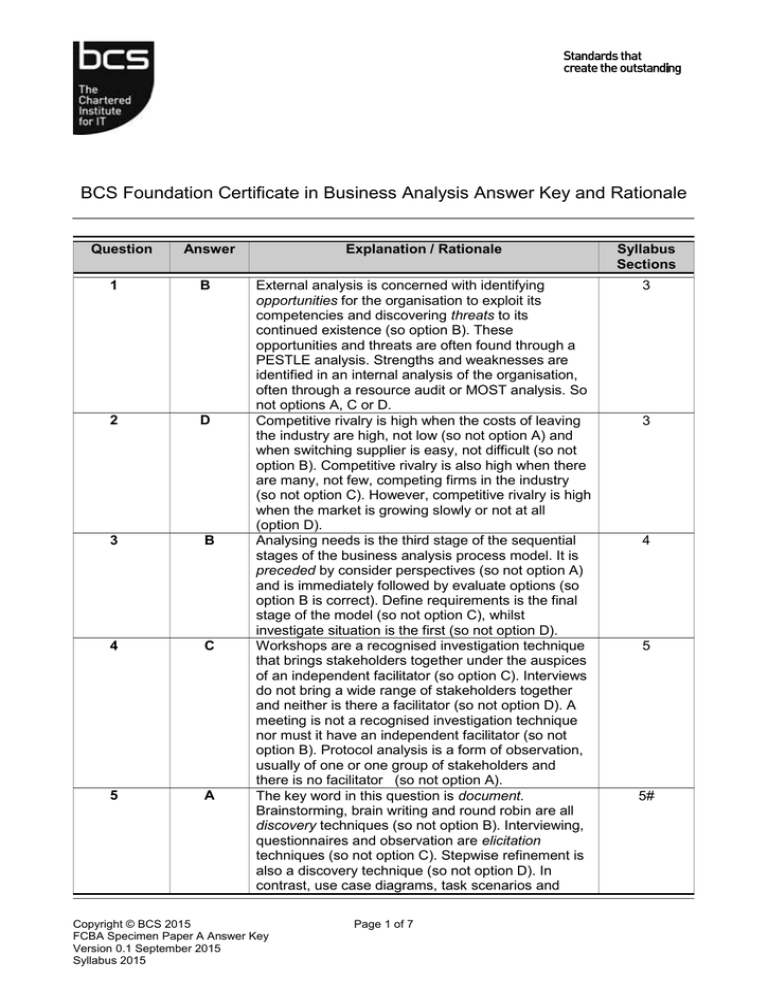Answer Key - BCS Certifications
advertisement

BCS Foundation Certificate in Business Analysis Answer Key and Rationale Question Answer 1 B 2 D 3 B 4 C 5 A Explanation / Rationale Syllabus Sections External analysis is concerned with identifying opportunities for the organisation to exploit its competencies and discovering threats to its continued existence (so option B). These opportunities and threats are often found through a PESTLE analysis. Strengths and weaknesses are identified in an internal analysis of the organisation, often through a resource audit or MOST analysis. So not options A, C or D. Competitive rivalry is high when the costs of leaving the industry are high, not low (so not option A) and when switching supplier is easy, not difficult (so not option B). Competitive rivalry is also high when there are many, not few, competing firms in the industry (so not option C). However, competitive rivalry is high when the market is growing slowly or not at all (option D). Analysing needs is the third stage of the sequential stages of the business analysis process model. It is preceded by consider perspectives (so not option A) and is immediately followed by evaluate options (so option B is correct). Define requirements is the final stage of the model (so not option C), whilst investigate situation is the first (so not option D). Workshops are a recognised investigation technique that brings stakeholders together under the auspices of an independent facilitator (so option C). Interviews do not bring a wide range of stakeholders together and neither is there a facilitator (so not option D). A meeting is not a recognised investigation technique nor must it have an independent facilitator (so not option B). Protocol analysis is a form of observation, usually of one or one group of stakeholders and there is no facilitator (so not option A). The key word in this question is document. Brainstorming, brain writing and round robin are all discovery techniques (so not option B). Interviewing, questionnaires and observation are elicitation techniques (so not option C). Stepwise refinement is also a discovery technique (so not option D). In contrast, use case diagrams, task scenarios and 3 Copyright © BCS 2015 FCBA Specimen Paper A Answer Key Version 0.1 September 2015 Syllabus 2015 Page 1 of 7 3 4 5 5# Question Answer Explanation / Rationale Syllabus Sections process models are all documentation techniques (so option A) 6 B 7 B 8 A 9 B 10 C Protocol analysis is an observation technique and a questionnaire has heading, classification and data sections (so not options A, C or D). Prototypes can be developed in workshops and a post-it note prototype can be just as valuable as a software prototype (so option B). A supporter is in favour of the project but will not be very active in promoting it (so not option A). In contrast a champion will promote and actively support it (so option B is correct). A critic is not in favour of the project so is unlikely to work for its success (so not option C). The same is true of a blocker who will obstruct progress (option D). A business perspective is a view of a stakeholder about their business area (so option A). A perspective may be a collective view but it is about the business situation, not its direction (so not option B). The business perspective does not have to be rational (so not option C), however the term rational is defined. It does contain external and internal aspects (for example; customers and actors) but these are not influences. These external and internal aspects are more likely to be summarised in a SWOT analysis (so not option D). A business event is something that triggers the business process to do something (so not option A). The business process usually forms part of a business activity or set of activities (so not option C). Identifying the business events will help analysts think about the processes that form the business system response (so not option D). The activities will be governed by constraints and operational guidance which form the business rules for how the activities will be performed (so option B is correct). A process is triggered by an event (option C). Activities take place within the process, they do not trigger it (so not option A). A function may be a business function or some functional requirement that the process has to satisfy. Again it is not a trigger (so not option B). A reaction is a response not a trigger (so not option D). Copyright © BCS 2015 FCBA Specimen Paper A Answer Key Version 1.0 October 2015 Syllabus 2015 Page 2 of 4 5 6 6 7 7 11 B 12 A 13 C The potential effect of the proposal on interdepartmental relations is part of the impact assessment (so option C). The cost/benefit analysis summarises tangible costs and tangible benefits associated with the proposal (so not option A). Interdepartmental relations will definitely be affected so it is not part of the risk assessment as this only considers events that might take place (so not option B). The proposal is likely to be only one of the options considered (so not option D). 9 14 A All four options presented in this question are parts of the requirements engineering process. Requirements elicitation is primarily concerned with discovering requirements, not agreeing them (so not option D). Although there are elements of validation in requirements analysis there is no need for business representatives to agree that they are accurate at this stage (so not option B). This agreement comes at the validation stage, so option A is correct. Once agreed, requirements are subject to requirements management (so not option C), which is primarily concerned with configuration and change control. 10 15 A A job description is an example of explicit knowledge at an individual level – so option A is correct. A user interface style guide is explicit knowledge at a corporate level (so not option C). An ability to use a spreadsheet is a tacit, individual skill (so not option D), whilst rumour about an acquisition might be classified as tacit, corporate knowledge (so not option B). 10 A value stream model shows the stages that create an outcome of value (so not option A). The POPIT model shows the areas to be investigated in order to identify required changes (so not option C). McKinsey’s 7-S model shows the interlinked components used in the implementation of strategic change (so not option D). A business capability model represents what an organisation needs to be able to do in order to deliver value to customers so option B is correct. It will be very difficult to measure the disruption and short-term loss in productivity in advance. So it is unlikely to be a tangible facet of the cost-benefit analysis (so not options B or D). The disruption will not be a benefit (so not option C), but a cost, so option A is correct. Copyright © BCS 2015 FCBA Specimen Paper A Answer Key Version 1.0 October 2015 Syllabus 2015 Page 3 of 4 9 16 A 17 B 18 D 19 D 20 A A functional requirement concerns business functions that the system might provide. A user amending customer details is an example of a functional requirement (option A). Security aspects, such as password protection, are perceived as nonfunctional requirements (so not option B), compliance with legislation is a general requirement (so not option C) and response time as a non-functional requirement (so not option D). Requirements analysis is part of the requirements engineering process (so not option A). Requirements filters are used in requirements analysis (so not option C). Stakeholder management precedes requirements definition (so not option D). Requirements management has six components; one of which is configuration management (option B). The system boundary separates actors from use cases on a use case diagram (option D). Classes and processes are not shown on a use case diagram (so not options B or C). Events trigger use cases but their content is not explicitly shown on the diagram and they certainly do not separate use cases from actors on the diagram (so not option A). Invoicing section describes who does the invoicing and is likely to be an actor on a use case diagram or swim lane diagram (so not option A). Record Invoice Details includes an active verb so is likely to be a use case (so not option B). Invoice number is only one of the data items likely to be held about an invoice and so is probably an attribute of a class (so not option C). Invoice is a relevant singular noun and would be an appropriate name for a class that holds details about an invoice. So option D is correct. Benefits realisation checks that the benefits predicted in the business case have actually been achieved (option A). It is concerned with business deliverables, not project deliverables, (so not option B). It is not concerned with establishing whether users realise that change has taken place (so not option C). The benefits management process is concerned with establishing whether the benefits have been properly identified, not benefits realisation (so not option D). Copyright © BCS 2015 FCBA Specimen Paper A Answer Key Version 1.0 October 2015 Syllabus 2015 Page 4 of 4 11 11 12 12 14

